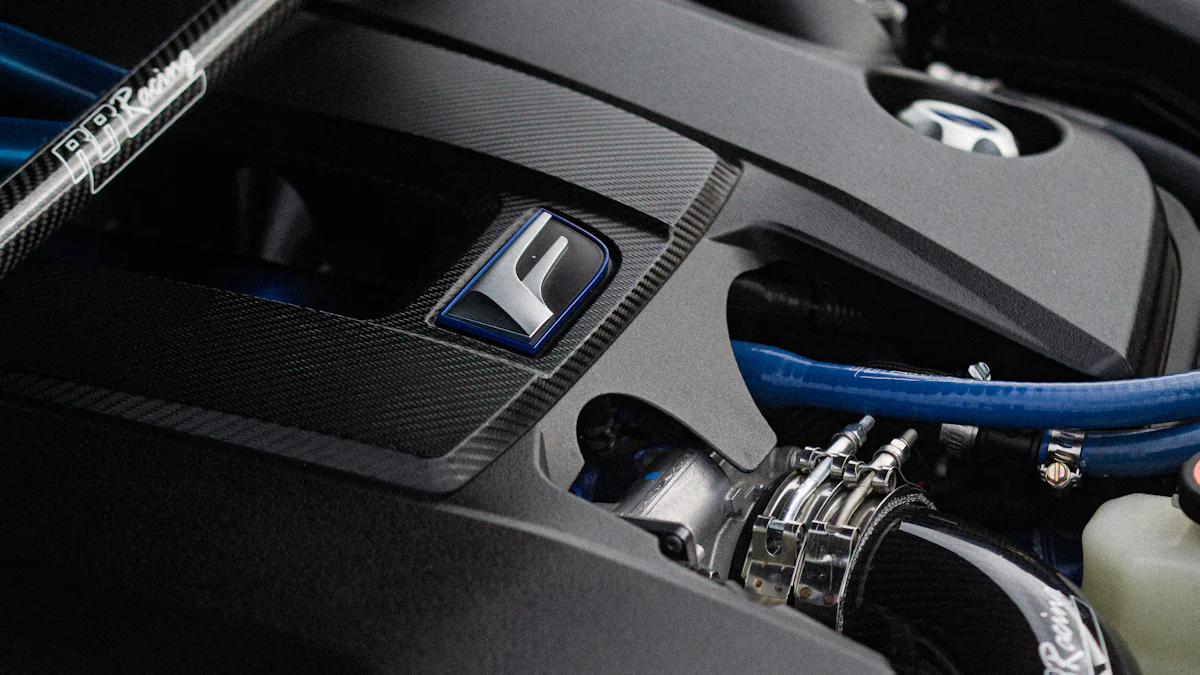Wie Kohlefaser den Fahrzeugbau revolutioniert

Carbon fiber has transformed the way vehicles are built. Its lightweight structure reduces a car’s weight significantly, improving fuel efficiency and lowering emissions. For every 10% reduction in vehicle weight, fuel consumption decreases by about 7%. This material also offers exceptional strength, enhancing crash protection and structural integrity. Unlike traditional metals, carbon fiber resists corrosion and lasts longer, making it a durable choice for modern automotive design. As manufacturers aim to create more efficient and sustainable vehicles, carbon fiber stands out as a revolutionary solution.
Wichtigste Erkenntnisse
Carbon fiber significantly reduces vehicle weight, leading to improved fuel efficiency and lower emissions—every 10% weight reduction can decrease fuel consumption by about 7%.
The material’s exceptional strength-to-weight ratio enhances safety and performance, making it ideal for structural components like chassis and frames.
Carbon fiber’s resistance to corrosion and high temperatures ensures durability, reducing maintenance needs and extending the lifespan of vehicles.
Innovative design flexibility allows manufacturers to create complex shapes and aerodynamic features, enhancing both aesthetics and functionality.
While carbon fiber production poses sustainability challenges, advancements in technology are paving the way for more eco-friendly manufacturing processes.
Fully carbon fiber vehicles, like the McLaren MP4-12C and Ferrari Enzo, showcase the material’s potential to redefine performance and design in the automotive industry.
Carbon fiber wraps and decorative components offer a cost-effective way to enhance vehicle appearance while maintaining performance benefits.
Die einzigartigen Eigenschaften von Carbonfaser
Geringes Gewicht und hohe Festigkeit
Carbon fiber stands out for its exceptional strength-to-weight ratio. This material is five times stronger than steel while being significantly lighter. You benefit from this unique property because it allows vehicles to maintain structural integrity without the added weight of traditional materials. A lighter vehicle improves fuel efficiency and reduces emissions. For instance, a 10% reduction in vehicle weight can lower fuel consumption by approximately 7%. This combination of strength and lightness also enhances safety, as carbon fiber absorbs impact energy effectively during collisions. Its high stiffness further contributes to better handling and acceleration, improving overall driving dynamics.
Resistance to Corrosion and High Temperatures
Unlike metals such as steel or aluminum, carbon fiber resists corrosion. You won’t have to worry about rust or degradation over time, even in harsh environments. This durability ensures that vehicles made with carbon fiber components last longer and require less maintenance. Additionally, carbon fiber performs well under extreme temperatures. It retains its structural integrity in both high-heat conditions and freezing climates. This makes it an ideal material for various automotive applications, from engine components to exterior panels exposed to the elements.
Design Flexibility
Carbon fiber offers unmatched design flexibility. Manufacturers can mold it into complex shapes and intricate designs that traditional materials cannot achieve. This flexibility allows for innovative vehicle designs that improve aerodynamics and aesthetics. You’ll notice that many high-performance and luxury cars feature sleek, futuristic designs made possible by carbon fiber. Beyond aesthetics, this adaptability also enables engineers to optimize the placement of carbon fiber components for maximum performance and efficiency. Whether it’s a lightweight chassis or a custom interior panel, carbon fiber provides endless possibilities for creative and functional automotive design.
How Carbon Fiber is Manufactured for Automotive Use
The Carbon Fiber Production Process
Creating carbon fiber involves a detailed and precise process. It begins with the production of carbon fiber filaments. Manufacturers use precursor polymers like polyacrylonitrile (PAN), which are spun into yarns. These yarns undergo oxidation to strengthen their molecular structure. Afterward, they are subjected to extreme heat in an oxygen-free environment, a step known as carbonization. This process removes all non-carbon elements, leaving behind pure carbon filaments.
Once carbonization is complete, the filaments are treated in a chemical bath. This treatment roughens their surface, enhancing their ability to bond with other materials. The filaments are then coated during a process called sizing, which protects them from damage during handling. Thousands of these filaments are bundled together to form rovings, which are stored on rolls for further use.
From these rovings, manufacturers create flat carbon-fiber cloth by layering the fibers. The direction of the fibers in each layer determines the material’s rigidity. For components requiring strength in multiple directions, engineers stack layers with varying fiber orientations. The cloth is then placed into molds, where it is combined with a resin, typically epoxy. This resin acts as a matrix, holding the fibers in place and providing additional strength. The mold is baked in an autoclave to solidify the material. Finally, the component is removed, finished, and coated with lacquer for protection and durability.
Challenges in Manufacturing
Producing carbon fiber components presents several challenges. The process is labor-intensive and requires advanced technology. Each step, from creating filaments to molding the final product, demands precision. This complexity increases production costs, making carbon fiber more expensive than traditional materials like steel or aluminum.
Another challenge lies in the environmental impact of manufacturing. The production of precursor polymers and the carbonization process consume significant energy. Additionally, the chemical treatments used can generate waste that requires careful disposal. These factors raise concerns about sustainability, especially as demand for carbon fiber grows.
Despite these challenges, advancements in technology are helping to streamline production. New methods, such as automated layup processes and improved resin systems, aim to reduce costs and environmental impact. As these innovations continue, you can expect carbon fiber to become more accessible for a wider range of automotive applications.
Applications of Carbon Fiber in Car Components

Strukturelle Komponenten
Carbon fiber plays a crucial role in the structural components of vehicles. You’ll find it used in chassis, roof panels, and even entire car frames. Its lightweight nature reduces the overall weight of the vehicle, which improves fuel efficiency and enhances performance. At the same time, its high strength ensures that these components maintain the structural integrity needed for safety. For example, many high-performance cars rely on carbon fiber to create rigid yet lightweight frames that improve handling and acceleration. This material also absorbs impact energy effectively, providing better crash protection compared to traditional metals like steel or aluminum.
Leistungsverbesserungen
When it comes to performance, carbon fiber is unmatched. Manufacturers use it in parts like drive shafts, suspension components, and aerodynamic elements such as spoilers and diffusers. These components benefit from the material’s superior strength-to-weight ratio, which enhances speed, agility, and overall driving dynamics. For instance, a carbon fiber drive shaft reduces rotational mass, allowing the engine to deliver power more efficiently. Similarly, lightweight suspension components improve responsiveness, giving you a smoother and more controlled driving experience. In motorsports, where every ounce matters, carbon fiber is a game-changer. It helps race cars achieve faster lap times while maintaining safety and durability.
Interior Components
Inside the vehicle, carbon fiber adds both functionality and style. You’ll often see it in dashboards, seat frames, and trim pieces. Its ability to be molded into intricate shapes allows designers to create sleek and modern interiors that stand out. Beyond aesthetics, carbon fiber’s lightweight properties reduce the overall weight of the car, contributing to better fuel efficiency. Seat frames made from this material are not only lighter but also stronger, providing enhanced safety and comfort. Additionally, carbon fiber’s durability ensures that these interior components last longer, even under constant use. High-end vehicles and supercars frequently feature carbon fiber interiors, showcasing its versatility and premium appeal.
Fully Carbon Fiber Cars: Examples and Innovations

Iconic Carbon Fiber Cars
Fully carbon fiber cars have redefined what vehicles can achieve in terms of performance, design, and efficiency. Some of the most iconic examples showcase how this material has pushed the boundaries of automotive engineering. The McLaren MP4-12C stands out as a pioneer in this field. It utilized a carbon fiber monocoque chassis, which significantly reduced weight while maintaining exceptional strength. This innovation not only enhanced speed and handling but also set a new benchmark for high-performance sports cars.
Another legendary example is the Ferrari Enzo. This supercar incorporated extensive carbon fiber components, including its body panels and interior elements. By doing so, Ferrari achieved a perfect balance between lightweight construction and structural rigidity. The result was a car that delivered unmatched agility and acceleration, cementing its place in automotive history.
In motorsports, the McLaren MP4 Formula One car revolutionized racing by introducing carbon fiber to the sport. Its lightweight yet durable construction became the standard for all Formula One cars, proving the material’s superiority in high-stress environments. Similarly, Porsche has embraced carbon fiber reinforced polymer (CFRP) in several of its models. By integrating CFRP into key components, Porsche reduced vehicle weight by several kilograms, improving both performance and fuel efficiency.
These examples highlight how fully carbon fiber cars have transformed the automotive landscape. They demonstrate the material’s ability to enhance speed, safety, and overall driving experience.
The Future of Fully Carbon Fiber Cars
The future of fully carbon fiber cars looks promising as advancements in technology continue to make this material more accessible. Manufacturers are exploring ways to reduce production costs and improve sustainability, which could lead to wider adoption across various vehicle segments. Currently, carbon fiber is predominantly used in high-performance and luxury cars. However, as production methods become more efficient, you may see it integrated into everyday vehicles.
Innovations in carbon fiber technology are also paving the way for entirely new vehicle designs. Engineers are experimenting with 3D printing techniques to create complex carbon fiber structures with minimal waste. This approach not only reduces environmental impact but also opens up possibilities for custom, lightweight designs tailored to specific performance needs.
Fully carbon fiber electric vehicles (EVs) represent another exciting frontier. The lightweight nature of carbon fiber can offset the weight of heavy battery packs, improving range and efficiency. As the automotive industry shifts toward electrification, carbon fiber could play a crucial role in making EVs more practical and appealing.
In the coming years, you can expect to see more groundbreaking innovations in fully carbon fiber cars. These vehicles will likely combine cutting-edge materials with advanced manufacturing techniques, delivering unparalleled performance, efficiency, and sustainability.
Cosmetic Uses of Carbon Fiber in Vehicles
Carbon Fiber Wraps
Carbon fiber wraps have become a popular choice for vehicle customization. These wraps mimic the appearance of real carbon fiber, offering a sleek and modern aesthetic without the high cost of actual carbon fiber components. You can apply these wraps to various parts of your car, such as the hood, roof, or side mirrors, to achieve a sporty and high-end look. They are available in different finishes, including matte, gloss, and textured options, allowing you to personalize your vehicle to match your style.
One of the key advantages of carbon fiber wraps is their versatility. You can easily install or remove them without causing damage to the original paint. This makes them an excellent option for temporary upgrades or protecting your car’s surface from scratches and UV damage. Additionally, wraps are lightweight and do not add significant weight to your vehicle, preserving its performance and efficiency. Whether you want to enhance your car’s appearance or protect its exterior, carbon fiber wraps provide a cost-effective and stylish solution.
Decorative Carbon Fiber Components
Decorative carbon fiber components elevate the interior and exterior design of vehicles. These components include trim pieces, dashboard accents, door handles, and even gear shift knobs. You’ll often find them in luxury and sports cars, where they add a touch of sophistication and exclusivity. The unique weave pattern of carbon fiber creates a visually striking effect that stands out in any vehicle design.
Beyond aesthetics, decorative carbon fiber components offer practical benefits. Their lightweight nature reduces the overall weight of the car, contributing to better fuel efficiency and handling. Additionally, carbon fiber’s durability ensures that these components resist wear and tear, maintaining their appearance over time. For example, a carbon fiber dashboard trim not only enhances the interior’s visual appeal but also withstands daily use without fading or cracking.
In the aftermarket community, carbon fiber decorative parts have gained immense popularity. Enthusiasts use them to upgrade their vehicles, giving them a custom and premium feel. Whether you’re looking to enhance your car’s interior or add a sporty touch to its exterior, decorative carbon fiber components provide a perfect blend of style and functionality.
The Environmental Impact of Carbon Fiber in Automotive Manufacturing
Sustainability Challenges
Carbon fiber has revolutionized vehicle manufacturing, but its production process presents significant sustainability challenges. Creating carbon fiber requires energy-intensive methods. The carbonization process, which involves heating precursor polymers like polyacrylonitrile (PAN) to extreme temperatures, consumes large amounts of energy. This step alone contributes to higher carbon emissions compared to traditional materials like steel or aluminum.
Chemical treatments used during production also raise environmental concerns. These treatments generate waste that requires careful disposal to prevent harm to ecosystems. Additionally, the reliance on non-renewable resources for precursor materials further complicates sustainability efforts. As demand for lightweight vehicles grows, these challenges become more pressing.
Efforts to address these issues are underway. Researchers are exploring alternative precursor materials, such as bio-based polymers, to reduce reliance on fossil fuels. Manufacturers are also investing in renewable energy sources to power production facilities. These steps aim to lower the environmental footprint of carbon fiber while maintaining its benefits for automotive applications.
Long-Term Benefits
Despite its environmental challenges, carbon fiber offers long-term benefits that contribute to sustainability in the automotive industry. Vehicles made with carbon fiber components are significantly lighter, which improves fuel efficiency. For every 10% reduction in vehicle weight, fuel consumption decreases by approximately 7%. This reduction leads to lower greenhouse gas emissions over the vehicle’s lifespan.
Carbon fiber also enhances vehicle durability. Its resistance to corrosion and wear means that cars last longer, reducing the need for frequent replacements. This longevity minimizes waste and conserves resources, making it a more sustainable option in the long run.
The material’s role in electric vehicles (EVs) further highlights its potential. Lightweight carbon fiber offsets the weight of heavy battery packs, improving range and energy efficiency. As the automotive industry shifts toward electrification, carbon fiber could play a crucial role in creating more efficient and environmentally friendly EVs.
In the future, advancements in recycling technologies may unlock new possibilities for reusing carbon fiber components. Researchers are developing methods to recover and repurpose carbon fibers from end-of-life vehicles, reducing waste and conserving resources. These innovations could make carbon fiber an even more sustainable choice for automotive manufacturing.
Carbon fiber has transformed vehicle manufacturing by offering lightweight, durable, and high-performing solutions. You see its impact in structural components, cosmetic enhancements, and even fully carbon fiber cars that redefine automotive innovation. While challenges like cost and sustainability remain, advancements in technology continue to address these issues. This material not only improves fuel efficiency and performance but also extends vehicle durability. As the industry evolves, carbon fiber will remain a cornerstone in shaping efficient, safe, and futuristic transportation.
